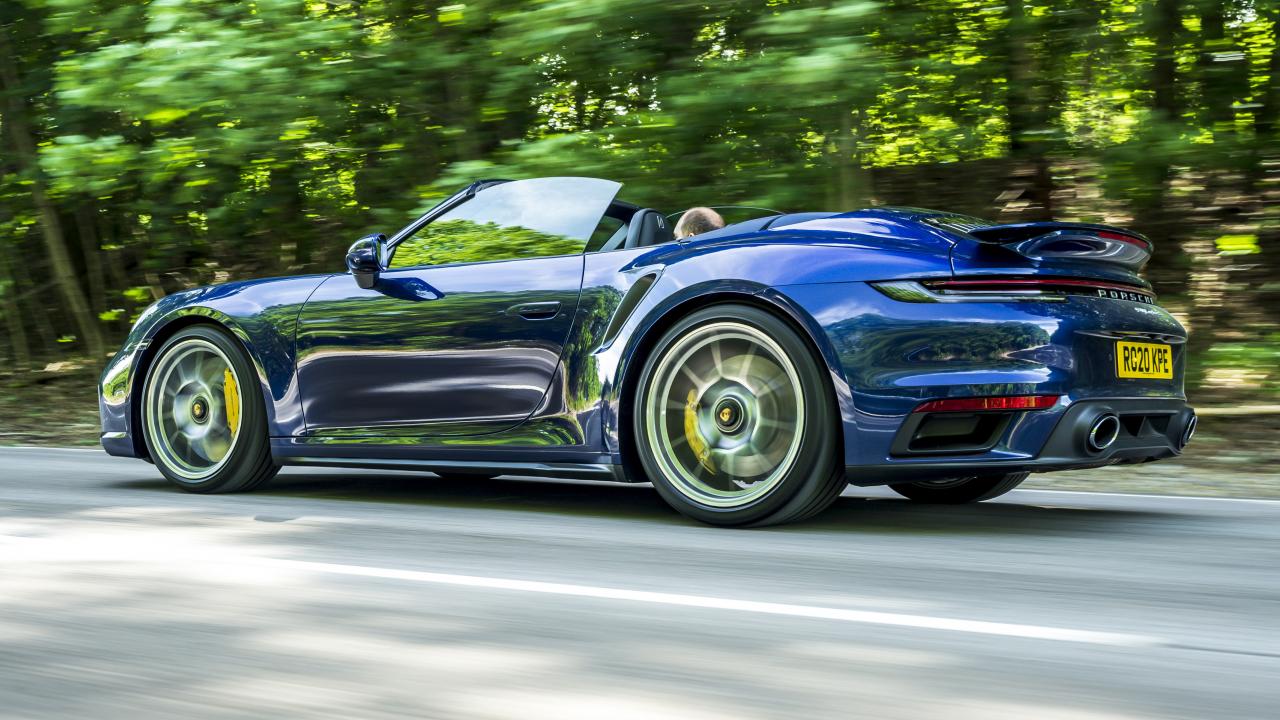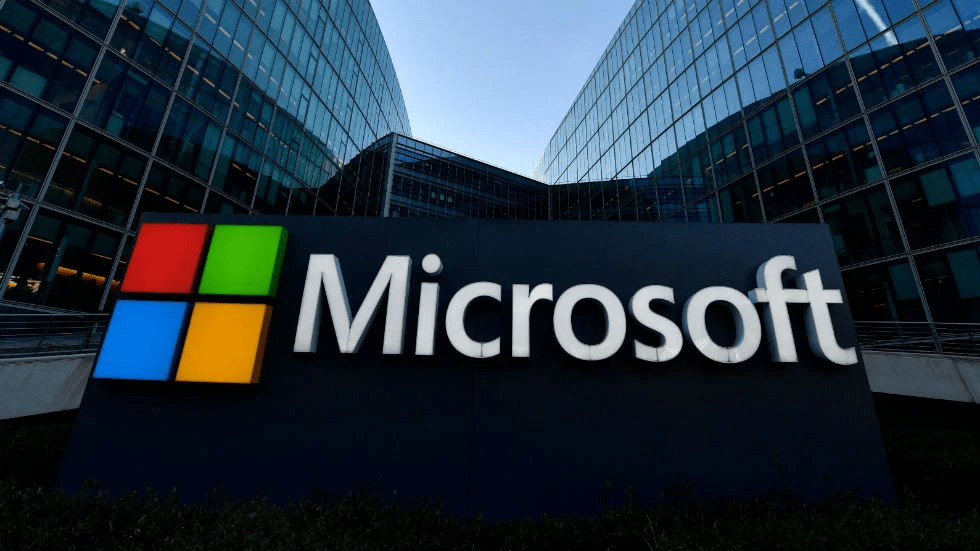Tech
Porsche 911 Turbo S Cabriolet review: first UK test – Top Gear

The 911 Turbo S Cabriolet, in the UK. But hasn’t it just started raining?
Well it is June. Fortunately, we got into the new car at the tail end of the hot weather, grateful for the fact that this first lockdown-easing drive involves a convertible roof. Porsche’s rules meant picking the car up from the company’s HQ just outside Reading, where it had just received the sort of deep clean that banishes all bug-like life-forms, including sub-atomic ones.
At the risk of sounding like a prissy purist, isn’t the 911 Turbo a car best enjoyed with a proper roof?
We’d tend to agree. The new Targa does the rug-ruffling cool thing, especially in its recently unveiled Heritage Design form, and you could make a case for the standard 911 soft-top.
But a 641bhp turbo with no roof? That’s the ultimate poser’s Porsche, the Beverly Hills plastic surgeon’s car, all the gear and no idea. But then we drove it, on some of Britain’s best roads.
First impressions?
Well here’s the thing. With this car, they can lull you into a sense of false security. You know about the 50-metre test, the idea that you can pretty much get the measure of a car within the first 50m? That’s true here, in the sense that this is a Porsche 911, so you sit quite low, you can see out in every direction much more effectively than in many equivalent supercars, it feels compact (if not quite as wieldy as earlier iterations), and all the control weights are nigh-on perfect. The 911, after all, is the definitive driving machine.
With no set route, I simply pointed the new Turbo Cab down the M4 and onto the A34. Its eight-speed PDK ’box shuffles imperceptibly into, erm, top gear, bumbles along on a negligible amount of revs, and despite having tyres the size of small planets, is almost limo quiet on a steady-state motorway cruise. It wasn’t until I saw the signs for Southampton that, initial acclimatisation complete, I properly buried the throttle pedal for the first time. At which point, well, words fail me. Apart from the naughty ones I can’t repeat here.
Can you try, please, otherwise this’ll be a short story.
Of course. TG’s latest print issue had the new 911 Turbo on the cover, with a bunch of turbo-related stories in support. History tells us that early adopters – in motorsport and on the road – had to cope with ferocious lag, which made the original mid-Seventies 911 Turbo, to give you one notable example, quite the beast. Forty-five years of progress has all but eliminated the scourge of lag, but the 930 Turbo’s 2020 successor still serves up so much thrust even on modest throttle loads it’s like surfing a rocket. Its ability to cover ground quickly is almost but not quite beyond belief. You are here. Then you are… there. The bit of tarmac in between is simply vaporised. In my experience, only the McLaren F1 and Bugattis Veyron and Chiron pull off the same trick. And one of those has a race-inspired V12, the others 32 cylinders and eight turbos between them.
But hasn’t that been a Turbo trait for at least the last two generations? Intergalactic acceleration yes, but rather clinically executed…
True. But this 992-era car somehow manages to stir a bit more emotion into the mix. It’s the difference between Arnie in the original Terminator film versus the joke-meister in T2: Judgment Day. Part of the experience is knowing that you are sitting in front of another piece of Weissach-created engineering magic. Full disclosure: the latest regular Carrera didn’t fully do it for me, itself now (twin) turbocharged in the modern idiom, a 3.0-litre flat-six making 450bhp. Wrangling the necessary efficiency out of it messed with its mojo a bit.
The new Turbo S engine is based on that unit, but it’s now 3745cc, has a wider bore, a new cooling system that feeds air via those pumped rear wheelarch intakes and two additional ones above the rear wing grille. There’s a new cooling system, symmetrical turbos with variable turbine geometry and electrically adjustable wastegate flaps, and piezo injectors: it’s more responsive, more powerful, torquier, more efficient, more everything.
More fun? Because no matter how fast the previous Turbo was, it was the GT3 that usually generated the big thrills.
Unquestionably. Having peeled off the A34 and into the south-west’s beautiful countryside, we traversed Hampshire, Sussex, Wiltshire and Berkshire, looping B-roads rising and falling and then flattening out towards Salisbury plain. The Turbo burbles unobtrusively through villages, its wider front and rear track (by 45mm and 10mm respectively), potent looking rear end and reworked front visual signifiers lost on all but the most well-informed.
When it’s safe to do so, third gear unleashes volcanic performance, and the sensation as you pass the 2,800rpm boost threshold and ride out the acceleration to the 7,000rpm red line is the sort of thing someone would make a fortune out of if they could bottle it. Now factor in what it’s like with the roof down: you can hear the turbos sucking, blowing and chumpfing, a sonic brew that alters in real time depending on what you’re doing with your right foot. What lag there is actually becomes part of the experience. The sense of thrust is amazing.
But is it all a bit sledgehammer smashing a nut?
I’ve driven every significant Porsche 911 there’s ever been, and this new Turbo won’t placate the diehards who hymn the lost art of steering feel. Nor does its tail do that signature 911 thing of hunkering down as you launch yourself out of a corner and then wonder what amount of bobbing nose understeer you’ll have to contend with on the exit. Those days are gone. No, it simply erases corners, like they’re not there. The front and rear end are in constant and crystal clear contact with each other, and the chassis firepower – all-wheel drive with a front axle that can handle 368 torques alone, active rear axle, all the high-end PASM, PDCC and PSM software – combines to deliver a car of unfathomable depths.
The front wheels are 20in shod in 255/35 Pirellis, the rears 21in wrapped in 315/50 rubber, and the immense mechanical grip is augmented by an enhanced set of aerodynamic aids: there’s an air brake, and the redesigned front and the new rear spoiler increase downforce by 15 per cent over the previous car. A rotary dial on the steering wheel moves through wet, normal, sport, sport plus and individal mode. In sport plus, the downforce on the rear wing is increased to 170kg. Braking, the oft-overlooked yet critical part of the equation, is by standard ceramic discs, 420mm at the front, grabbed by 10-piston calipers. The retardation is obviously immense, but there’s terrific feel too. The result is a car whose limits are so high, in all weather conditions and regardless of the road surface beneath, that is impossible to disrupt. If this suggests a certain thuggishness, that’s not the case, although it is true that other cars are more nuanced, will convey more detail about the road and its composition, that weigh less and move around a bit more, if that’s your bag. That it weighs an extra 69.8kg over the coupe is neither here nor there, although at 1.7 tonnes overall it’s no featherweight.
Still, few if any cars combine the Turbo’s unbelievable velocity with its sense of control and crushing capability: Ollie Marriage of this parish recorded a 0-60mph time of 2.5 seconds, 100mph in 5.6 in the coupe. These are extraordinary numbers.
Back to the convertible bit, now.
Well, you pays your money etc. And as it costs £165,127, we’re talking a chunk of change here (£10k more than the coupe). And our test car added some interesting extras. Some, like the adaptive cruise (£1203) and Lane Keep Assist (£749), are a waste of time. But we’d like the Sports exhaust (£2180), the Burmester audio (£2256), and even the air vents can be trimmed in leather (£1313). All up, this is a £178,414 car. Sheesh. The roof goes up or down in 12 seconds, and clever design ensures that there’s minimal turbulence at motorway speeds in the cockpit. A rear wind deflector tames the airflow inside at higher speeds. The body itself is rock solid, the whole thing feeling as meticulously well-engineered as you’d expect. We’d go so far as to say that the Cabriolet, even in Britain’s perpetually unpredictable climate, is the Turbo to go for. Simply because in a car that delivers an overwhelming sensory overload, the rush of air over your head adds yet another dimension.
Hmm. You liked it, then.
We’re in a world in which internal combustion is under threat, and it feels like the ‘traditional’ supercar might be about to run out of road. The new 911 Turbo S suggests that the end of days isn’t here just yet. It requires monumental self-discipline, and can do things only the very best fast cars before it managed to do. But it also morphs into a remarkably comfortable everyday car, complete with Porsche’s latest and impressive UX. It is completely uncompromised, and mesmerisingly good.
Specs: 3745cc, flat 6cyl twin turbo, 8sp PDK, 641bhp at 6750rpm, 590lb ft at 2500-4500rpm, 0-62mph 2.8 seconds, top speed 205mph, 25mpg combined, 257g/km CO2
Tech
Google Unveils AI-Powered Pixel 9 Lineup Ahead of Apple’s iPhone 16 Release
Google has launched its next generation of Pixel phones, setting the stage for a head-to-head competition with Apple as both tech giants aim to integrate more advanced artificial intelligence (AI) features into their flagship devices. The unveiling took place near Google’s Mountain View headquarters, marking an early debut for the Pixel 9 lineup, which is designed to showcase the latest advancements in AI technology.
The Pixel 9 series, although a minor player in global smartphone sales, is a crucial platform for Google to demonstrate the cutting-edge capabilities of its Android operating system. With AI at the core of its strategy, Google is positioning the Pixel 9 phones as vessels for the transformative potential of AI, a trend that is expected to revolutionize the way people interact with technology.
Rick Osterloh, Google’s senior vice president overseeing the Pixel phones, emphasized the company’s commitment to AI, stating, “We are obsessed with the idea that AI can make life easier and more productive for people.” This echoes the narrative Apple is likely to push when it unveils its iPhone 16, which is also expected to feature advanced AI capabilities.
The Pixel 9 lineup will be the first to fully integrate Google’s Gemini AI technology, designed to enhance user experience through more natural, conversational interactions. The Gemini assistant, which features 10 different human-like voices, can perform a wide array of tasks, particularly if users allow access to their emails and documents.
In an on-stage demonstration, the Gemini assistant showcased its ability to generate creative ideas and even analyze images, although it did experience some hiccups when asked to identify a concert poster for singer Sabrina Carpenter.
To support these AI-driven features, Google has equipped the Pixel 9 with a special chip that enables many AI processes to be handled directly on the device. This not only improves performance but also enhances user privacy and security by reducing the need to send data to remote servers.
Google’s aggressive push into AI with the Pixel 9 comes as Apple prepares to unveil its iPhone 16, which is expected to feature its own AI advancements. However, Google’s decision to offer a one-year free subscription to its advanced Gemini Assistant, valued at $240, may pressure Apple to reconsider any plans to charge for its AI services.
The standard Pixel 9 will be priced at $800, a $100 increase from last year, while the Pixel 9 Pro will range between $1,000 and $1,100, depending on the model. Google also announced the next iteration of its foldable Pixel phone, priced at $1,800.
In addition to the new Pixel phones, Google also revealed updates to its Pixel Watch and wireless earbuds, directly challenging Apple’s dominance in the wearable tech market. These products, like the Pixel 9, are designed to integrate seamlessly with Google’s AI-driven ecosystem.
Google’s event took place against the backdrop of a significant legal challenge, with a judge recently ruling that its search engine constitutes an illegal monopoly. This ruling could lead to further court proceedings that may force Google to make significant changes to its business practices, potentially impacting its Android software or other key components of its $2 trillion empire.
Despite these legal hurdles, Google is pressing forward with its vision of an AI-powered future, using its latest devices to showcase what it believes will be the next big leap in technology. As the battle for AI supremacy heats up, consumers can expect both Google and Apple to push the boundaries of what their devices can do, making the choice between them more compelling than ever.
News
Microsoft Outage Hits Payment Processors

When major payment processing systems have problems, the issues impact many critical systems that society depends on. In this article, we’ll explain the cause of the Microsoft outage and discuss the impact computer networking issues had on Canada. We’ll also examine whether or not Microsoft was at fault and what businesses can do to prevent further outages.
What Happened With the Microsoft Outage?
The outage with Microsoft’s Azure payment processor resulted from a buggy security update from an outside company, CrowdStrike. CrowdStrike offers information technology security services for many Microsoft Windows computers. The company’s software developers sent a new update out, but instead of patching up minor issues with the existing software, the code within conflicted with Windows and prevented computers from booting up. Users expecting to start their computers for a typical day were instead faced with the dreaded “Blue Screen of Death” error message.
So, how does this produce a problem and a payment processor issue? Many computers running payment processing, among many other kinds of software used for airlines, banks, retail, and other essential services, couldn’t start and were unable to let payments through. This is a catastrophic issue for companies that are heavily reliant upon the speed and ease of an electronic transaction.
In Canada, the outage impacted critical computer systems for air travel. Flights couldn’t be paid for and booked, which caused major problems for customers unable to make transactions while flights remained grounded. Travellers stuck waiting for flights to take off made their way over to the airports’ Starbucks and other vendors, only to discover unusually long lines due to payment issues. Even online gamblers looking to take their minds off the situation couldn’t take full advantage of one of the fastest payment options out there because of the outage.
Aside from payments, hospitals for major health systems had to use paper to complete important tasks like ordering lab work and getting meals to patients. Emergency dispatch lines were temporarily unable to function correctly while their computer systems were down.
How Was the Outage Fixed?
Thankfully, CrowdStrike fixed the problem on their end quickly, mostly via an additional reboot that allowed CrowdStrike to send over unflawed code. Unfortunately, for some business and private customers, rebooting wouldn’t be enough with command-line level adjustments needed for the operating system to run correctly.
The Good and Bad of Outages
First, we’re thankful that the outage was not caused by hackers accessing and stealing a mountain of personal data. A recent outage with an automotive software provider went on for much longer and ended much worse for software provider CDK, which likely paid an undisclosed sum north of $20 million to get data back and systems restored.
By some chance, Microsoft is reported to have experienced its own outage, and many information technology professionals blame Microsoft in part for their issues because of how their systems attempted to fix the problem by rebooting over and over again, though some of Microsoft’s PCs needed to warn users to make a change manually. Unfortunately, any computer that required manual intervention took longer to recover, as a knowledgeable person had to access each computer affected by the issue. In some cases, between dealing with several hours of backlogged tasks and slow recovery processes, some businesses took days, not hours, to get back online.
The outage brings up another major point in the cybersecurity and computer industry. CrowdStrike and Microsoft are both big companies in their respective fields. As a result, the effects of bad code spread much further than they could have if there were more competitors making security products or if there were more software companies making operating systems like Windows. While only 8 million computers were believed to be affected out of a much larger global network, those are essential computers for worldwide communication and payment processing. Perhaps companies should be putting their eggs in more than one basket?
The testing methods for the outage are unclear—did CrowdStrike test the routine software update enough to detect the potential for a major outage? Apparently not.
What Should Businesses Do Next?
Software like Microsoft Azure’s payment systems come from what information technology professionals call ‘the cloud.’ The software is remotely managed over the internet, meaning that the computer that runs the system is not physically present at the location. Unfortunately, this also means that an issue with the internet can take critical systems out of service.
Businesses ranging from major airlines and banks to mom-and-pop stores would be well served by backup systems at their locations. These don’t have to be as primitive as the old-fashioned credit-card carbon-copy slide, but there are options available with consistent service that don’t repeatedly rely on the same networks.
Conclusion
There were certainly challenging moments for Canadian businesses and emergency services during the CrowdStrike and Microsoft outage. As they scrambled to understand the problem and waited, albeit briefly, for issues to resolve, many companies learned the importance of having local and reliable backup for their computer systems.
Tech
New photos reveal more details about Google’s Pixel 9 Pro Fold

Google’s secret new line of Pixel 9 phones isn’t that big of a secret anymore. Taiwan’s National Communications Commission (NCC) released new photos of the phones including the Pixel 9 Pro Fold from almost every conceivable angle.
Android Authority found the photos in the NCC archives and uploaded galleries of each of the four phones including the Pixel 9, 9 Pro, 9 Pro XL and 9 Pro Fold. They reveal some interesting details about the new Pixel phones.
The charging rates will be a little faster than the last generation of Pixel phones: Taiwanese authorities measured 24.12W for the base model, 25.20W for the Pro and 32.67W for the 9 Pro XL. The Pixel 9 Pro Fold, however, was the slowest of all of them at 20.25W. These numbers don’t often match up perfectly with the advertised ratings, so expect Google to be promoting higher numbers at its event.
Speaking of chargers, it looks like Google needed a bigger charger to power its new phones. Photos included in the NCC leak show each phone will come with a wall charger that’s around 45W depending on which model you purchase. The charger’s plug moved from the middle to the top of the brick.
The latest photo dump also shows the 9 Pro Fold unfolded for the first time. Google has moved the selfie camera to the inside screen for a wider field of view. The 9 Pro Fold also has a slimmer top and bottom, a reduced fold crease on the display and a full 180 degree unfolding angle to make a screen that’s just over 250mm or just under 10 inches.
These photos are the latest in a very long list of leaks of Google Pixel 9 photos. The last Pixel 9 leak came down yesterday showing two prototype models of the base and XL models. Google might look into buying a new combination lock for the high school locker where they apparently keep all their unreleased gear.

-

 News13 hours ago
News13 hours ago‘The deal is done:’ NDP Leader pulls out of supply and confidence deal with Liberals
-

 Health8 hours ago
Health8 hours agoManhood Miracle
-

 Sports7 hours ago
Sports7 hours agoUS Open: Jessica Pegula upsets No. 1 Iga Swiatek to reach her first Grand Slam semifinal
-

 Health6 hours ago
Health6 hours agoAncient Tonic Discovered 6,092 Years Ago By “Seer Of The Gods”… Boosts T — Restores “Horse Power” Libido And Energy In Just 8 Seconds…
-

 News10 hours ago
News10 hours agoCouche-Tard Inc. reports Q1 profit down from last year as consumers watch spending
-

 News7 hours ago
News7 hours agoCanfor shutting two northern B.C. sawmills affecting 500 staff, blames U.S. tariffs
-

 News11 hours ago
News11 hours agoRoaring Game Returns: Olympic qualification a key storyline this curling season
-

 News10 hours ago
News10 hours agoSuspect in deadly Vancouver stranger attacks was on probation: VPD chief




















